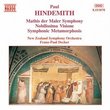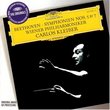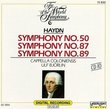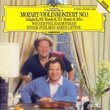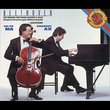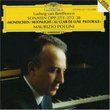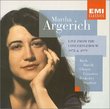| All Artists: Franz Joseph Haydn, Emanuel Ax Title: Haydn: Piano Sonatas Nos. 33, 38, 58, 60 Members Wishing: 0 Total Copies: 0 Label: Sony Original Release Date: 1/1/2005 Re-Release Date: 10/25/2005 Album Type: Original recording remastered Genre: Classical Styles: Chamber Music, Forms & Genres, Sonatas, Historical Periods, Classical (c.1770-1830) Number of Discs: 1 SwapaCD Credits: 1 UPCs: 827969276624, 082796927662 |
Search - Franz Joseph Haydn, Emanuel Ax :: Haydn: Piano Sonatas Nos. 33, 38, 58, 60
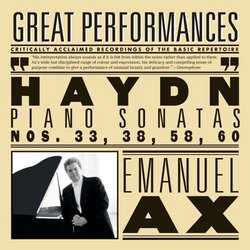 | Franz Joseph Haydn, Emanuel Ax Haydn: Piano Sonatas Nos. 33, 38, 58, 60 Genre: Classical
|
Larger Image |
CD DetailsSimilarly Requested CDs
|
CD ReviewsEmanuel Ax Plays Haydn Sonatas Robin Friedman | Washington, D.C. United States | 06/16/2007 (5 out of 5 stars) "In the mid-1980's Emanuel Ax recorded three volumes of Haydn piano sonatas in what was anticipated would ultimately become a complete set. The project has stalled, but fortunately there is a great deal to be enjoyed in Ax' recordings of Haydn. ( A fourth recording appeared a decade after the earlier efforts.) This CD consists of Ax' first Haydn recording and it has been reissued as part of Sony's budget-priced "Great Performance" series. It includes four sonatas from different periods of Haydn's work in the form. Haydn composed keyboard sonatas throughout his career, beginninng in the early 1760s. and concluding during his second trip to London in 1795. As with his symphonies, a listener can follow the development of the form in Haydn's increasing mastery over the years of the keyboard sonata. The earliest sonata on this CD is no. 33 in C minor, Hob. 20. This work dates from 1771 and is a worthy companion to the famous minor-key symphonies, including no 39 in g minor, no. 26, the "Lamentation" symphony, and no. 49 "La Passione" that Haydn was composing at about this time. The sonata is in three movements, with passionate and expansive outer movements in C minor and a singing, highly ornamented andante con moto for the middle movement. The sonata no. 38 in F major Hob. 23 is also a three-movement work composed somewhat later in 1773. This piece is part of a series of six sonatas Haydn composed for his patron,Prince Nicolaus Esterhazy. It has been described as containing "some of Haydn's very best keyboard music" along with its companions in the sonatas dedicated to Esterhazy. It is contemporaneous with symphonies Haydn composed numbered in the 50s. The piano sonata is a flowing graceful work with a rapid, opening movement with a free-style development section. The opening movement is based upon a single theme which Haydn develops and subjects to a variety of pianistic treatments. The sonata has a distant, sadly lyrical almost Neapolitan slow movement which contrasts with the opening movement and a short humorous finale with sudden stops and a surprising quiet ending. The two remaining sonatas on this CD date from Haydn's final years of composition. The unusual two-movement sonata no 58 in C major Hob. 48 dates from 1789, making it contemporaneous with Haydn's great symphony no. 88 and the other three symphonies before the "London" set. This work opens with a lengthy improvisatory slow movement which has been well-described as "one of Haydn's most expressive movements, cast in a free (non-strophic) version of his characteristic double-variation form". Haydn states a theme in C major, gives a variant of the theme in C minor and then alternates through the movement in varying the major and the minor themes. The movement makes a great deal of rolled chords. The finale is a great contrast in its brevity, quick tempo, and tight construction. The final work on the program is the sonata no. 60 in C major, Hob 50. Haydn composed this work in 1795 in London while working on the second set of "London" symphonies. This is a large-scaled, expansive work. The opening allegro is again monothematic in character as Haydn offers several variations on his theme as well as treating it with counterpoint. This movement is "perhaps the most inventive combining of sonata form with elements of variation in Haydn's output." The second movement is heavily ornamented with long descending runs and a great deal of filigree. It also features blocked and rolled chords. The finale is rapid and short with a stacatto theme. Ax is an excellent and idiomatic performer of Haydn. This CD offers a welcome opportunity to sample some of Haydn's finest piano sonatas. The quotations in this review are taken from the entry "Keyboard sonatas" in the invaluable reference work, the "Oxford Composer Companion to Haydn" edited by David Wyn Jones. Robin Friedman" Ecstasy! L. Polgar | Laguna Beach, CA | 06/14/2009 (5 out of 5 stars) "I heard this recording by Ax in my car while driving home from work while listening to the SIRIUS Symphony station-and loved it. I immediately got on line and bought it and have been playing it at home and in the car ever since. I haven't paid attention to Ax recordings for quite some time-not since I owned several on vinyl 30 years ago. I may have owned this very recording. Listening to a classical music station I learn a good deal -as much as I did in college when I used to go to the symphony once or twice a week as a grad. student at the U. of Toronto...2 Canadian dollars and a university card got one in to the symphony or opera where one could experience Rostropovich, Ashkenazy, Horowitz and etc.! I would then go to record stores and spend hours reading and learning from record jackets ( ah, the good old days). Knowing several musicians at that time who could advise helped as well. So, that is my pedigree ( as it were). Buy this recording. It is the 100th anniversary of the death of Haydn at the end of June 2009...celebrate with these recordings. You will not be disappointed. A music lover."
|

 Track Listings (11) - Disc #1
Track Listings (11) - Disc #1